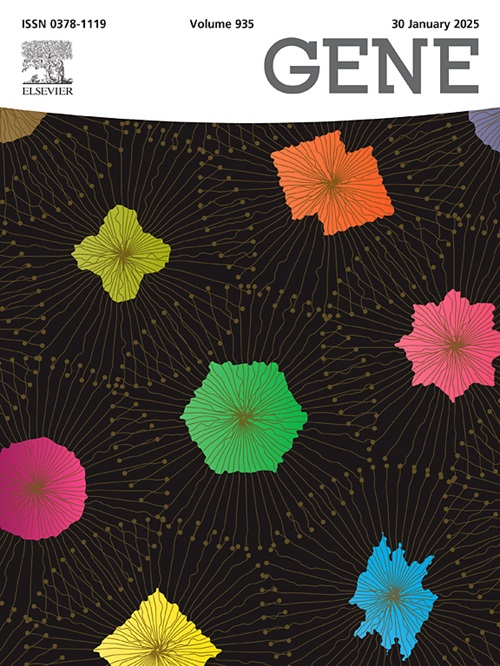胆结石疾病风险的遗传易感位点和预测/诊断模型
IF 2.4
3区 生物学
Q2 GENETICS & HEREDITY
引用次数: 0
摘要
本研究通过对197例病例和191例对照的全血样本进行测序,筛选并确定了高频突变位点。随后,采用自主开发的二维PCR (2D-PCR)方法,对595例患者和393例对照患者(TM4SF4 (rs9843304)、GCKR (rs1260326)和CYP7A1 (rs6471717)的GSD易感位点进行基因分型,并通过全基因组关联研究(GWAS)确定易感位点。我们比较了这些组的基因型和等位基因频率,并进行了单变量和多变量logistic回归分析,以确定GSD的危险因素。使用R编程语言开发预测模型,并通过受试者工作特征(ROC)曲线、校准图和决策曲线分析(DCA)进行验证。在调整性别和年龄后,与CC基因型相比,rs9843304 TT基因型(OR: 0.51, 95 % CI: 0.36-0.74, P < 0.001)和rs1260326 TT基因型(OR: 0.65, 95 % CI: 0.45-0.95, P = 0.03)与GSD风险较低显著相关。构建并验证了两种形态图:(1)包括肝功能检查的综合诊断模型,(2)不包括肝功能检查的流线型预测模型。采用ROC曲线、校正图和DCA评估鉴别、校正和临床应用。完整模型的auc分别为0.800(训练)和0.806(验证);简化模型达到0.713和0.746。校正曲线表明拟合良好,DCA显示简化模型的净效益阈值为0.38-1.00(训练)和0.30-1.00(验证),完整模型的净效益阈值为0.18-1.00。总之,2D-PCR提供了一种高效、低成本的GSD基因筛查平台,其形态图可实现适合初级保健和健康检查环境的个性化风险预测。本文章由计算机程序翻译,如有差异,请以英文原文为准。
Genetic susceptibility loci and predictive/diagnostic model for gallstone disease risk
This study screened and identified gallstone disease (GSD) high-frequency mutation sites through sequencing of whole blood samples from 197 cases and 191 controls. Subsequently, a self-developed two-dimensional PCR (2D-PCR) method was employed to genotype the GSD susceptibility loci, which were determined through genome-wide association studies (GWAS), in 595 cases and 393 controls: TM4SF4 (rs9843304), GCKR (rs1260326), and CYP7A1 (rs6471717). We compared the genotype and allele frequencies among these groups, and performed univariate and multivariate logistic regression analyses to identify risk factors for GSD. The R programming language was used to develop a predictive model, validated through receiver operating characteristic (ROC) curves, calibration plots, and decision curve analysis (DCA). After adjusting for sex and age, the rs9843304 TT genotype (OR: 0.51, 95 % CI: 0.36–0.74, P < 0.001) and and rs1260326 TT genotype (OR: 0.65, 95 % CI: 0.45–0.95, P = 0.03) were significantly associated with a lower risk of GSD compared to the CC genotype. Two nomograms were constructed and validated: (1) a comprehensive diagnostic model including liver-function tests, and (2) a streamlined predictive model excluding them. Discrimination, calibration and clinical utility were assessed with ROC curves, calibration plots and DCA. The full model achieved AUCs of 0.800 (training) and 0.806 (validation); the simplified model reached 0.713 and 0.746. Calibration curves indicated a good fit and DCA showed net-benefit thresholds of 0.38–1.00 (training) and 0.30–1.00 (validation) for the simplified model, and 0.18–1.00 for the full model. In summary, 2D-PCR offers an efficient, low-cost platform for GSD genetic screening, and the nomograms enable individualized risk prediction suitable for primary-care and health-check settings.
求助全文
通过发布文献求助,成功后即可免费获取论文全文。
去求助
来源期刊

Gene
生物-遗传学
CiteScore
6.10
自引率
2.90%
发文量
718
审稿时长
42 days
期刊介绍:
Gene publishes papers that focus on the regulation, expression, function and evolution of genes in all biological contexts, including all prokaryotic and eukaryotic organisms, as well as viruses.
 求助内容:
求助内容: 应助结果提醒方式:
应助结果提醒方式:


